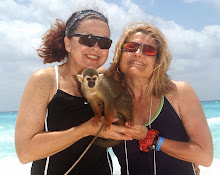Report pre on post surgery by Dr. Keith Allen- 7/12/2010
On July 2nd Ellie re-presented to me for surgical stabilization of an Atlanto -Axial luxation. Ellie had done well for several months with a conservative approach by bandaging the cervical region but had had problems with respiratory issues after extended bandaging. Her neurological signs had stabilized for 2 months and then relapsed. It appeared at this point that the best option for her long term was surgical stabilization.
The surgical technique chosen was to stabilize C1-C2 with a ventral approach using screws across the C1-C2 joints and PMMA. At surgery the AA joint appeared very unstable and the anterior body of C2 was displaced cranially and dorsally into thespinal canal. The body of C2 was retracted out of the spinal canal and reduced into a more normal anatomical position. I attempted to pass a 1.5mm screw across each C1-C2 joint space but the implants would not hold. At this point I elected to cross pin the joint spaces which was very successful. The pins provided rigid stability and were reinforced with wire and PMMA.
Following surgery, Ellie was very comfortable and was kept sedated and quiet overnight. We planned on re-bandaging her the next morning. Ellie was walking normally the next day and very comfortable. Unfortunately Ellie started regurgitating and vomiting that night and due to her prior history of respiratory problems in the bandage I felt it was safer to keep her quiet while we got her GI symptoms under control. I was worried about her developing aspiration pneumonia. Ellie’s GI signs resolved but she developed some upper airway nasal congestion from the vomiting and again I was concerned about re-bandaging at that point. Injectable antibiotics were switched to more broad spectrum medications in case of pneumonia.
On Sunday, July 4th, she still had some nasal congestion and had developed aproductive cough suggesting she may have some mild aspiration pneumonia that was responding to medical therapy. She was eating more, was comfortable and walking well throughout the day.
At 11:30pm on Sunday evening, after completing an emergency surgery at the hospital
I went to check on Ellie in her cage. She walked up to me wagging her tail and then collapsed in my arms. Her heart rate fell to 30 beats per minute. Ellie was non-responsive initially, I administered intravenous atropine and corticosteroids and her heart responded, but she remained lethargic. Her breathing was shallow and rapid. She returned to a normal heart rate and breathing rate for about 10 minutes until another episode of collapse occurred.
I elected to radiograph her chest and cervical spine. The surgical repair was intact and
her chest showed no abnormalities. Despite the repair being intact I re-bandaged her to see if it would make a difference in her signs, but episodes of collapse continued throughout the night but she was becoming less responsive to atropine and her breathing was more erratic.
At 7am on Monday, July 5th, she had a major episode of collapse, withbradycardia and and an acute onset of an abnormal breathing pattern. It became evident that Ellie was losing normal brainstem control of heart rate and breathing. At that point I called Sheryll and recommended that she and Lynn come up right away. We sedated and intubated Ellie to take control of breathing and heart rate. When they arrived we felt considering her continued decline the best decision although heart breaking was to let her go.
I wish I could be certain of what happened and why Ellie progressed as she did. Her signs appeared to be brainstem related and I feel they may have been related to either an acute bleed, infarct or development of acute swelling of brainstem for some reason but I cannot be certain.
Ellie was a wonderful puppy and really loved life, she was a wild child and truly loved her parents who are some of the most devoted and loving owners I have ever met. I know this a really difficult time for everyone and I will always second guess everything that happened. Ultimately, I feel we all gave her the best possible chance and I feel her spirit and spunk will live on in all of those who were lucky enough to have been touched by such a wonderful little girl.
.
Keith Allen, MVB, MS, Diplomate, American College of Veterinary Surgeons

No comments:
Post a Comment